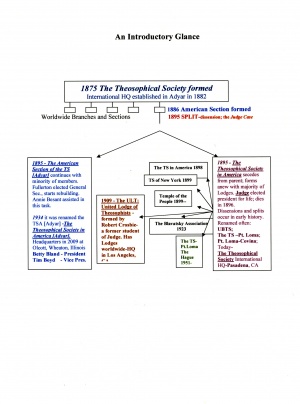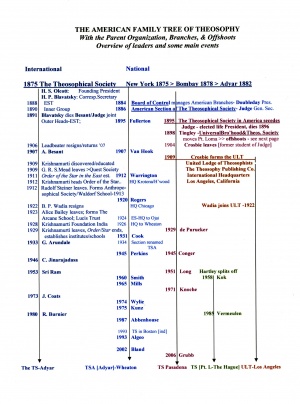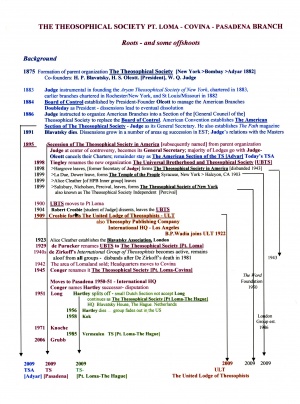Theosophical Movement
Theosophical Movement is a broad term indicating organizations and philosophies of the modern era influenced by the teachings of Helena Petrovna Blavatsky and her original Theosophical Society.
Family tree of Theosophical organizations
In 2009, Dorothy Bell of the Theosophical Society in Australia (associated with the TS based in Adyar, India) worked out a series of diagrams accompanying a philosophical article called "Roots and Shoots: A Preface." She wrote:
To some extent, the events and timelines of the American Family Tree of Theosophy disguise the true nature of its evolutionary life — the cycles and patterns of growth, decline, and rebirth and within them, the struggles to bring the original purpose of the Theosophical Society into fruition.
New seasons have seen some branches of the Family Tree thicken and extend offshoots, as others wither and die. In pushing up from underground and finding new garden beds, new runners from the main roots have found their own place in the sun — while appearing separate. On the original tree, storms have damaged branches sometimes splitting them asunder. And in the fullness of cycles, leaves have fallen and others have grown, taking their place on twigs and other offshoots, pushing out to find the light, and responding to the same living, vibrating impulse for life expression and expansion.
The impulse of the Heart that sowed its seed in 1875 and grew the outer vehicle — The Theosophical Society — to carry the Light of Wisdom into the world, is still with us today in the hearts of many who are responding anew to its original call, but who find themselves under different labels, in different boxes, and in different territories.
Over the years, lines of demarcation have been drawn in the sand, fences have been built, territories established and guarded. In time, lines drawn in sand lose their definition, but not so those lines in the mind that are caught in memory, in history. In the past, perceptions of lost ideals, wrong directions, and diluted teachings bred disharmony, division, and separation — and new patterns of birth, growth and renewal, or decline and decay, evolved.
But the original impulse that produced the seed and the tree, the branches and offshoots, the underground runners with their place in the sun, is still within, seeking expression and fulfillment. There is no need to change any boundaries, annex other territories, or dissolve any compartments, save in the prison of the mind. And a mind that is crippled by memory — by separation and fear — can never be free. We can find our own place in the sun by going beyond the bondage of the past and serving that impulse wherever we be. That is our territory; that is our center; that is our Theosophical family.
The American Family Tree of Theosophy
The aim has been to produce something accessible, simple and useful. It is an initiative of the President, Betty Bland, in response to those members at the Joy Mills Krotona Invitational 2009 who expressed interest in finding out more about the bigger picture of the Theosophical movement in America — beyond our own organization — The Theosophical Society in America [Adyar]. The following diagrams, while overlapping and becoming more complex, are a work in progress, as they attempt to describe, in a restricted mode of presentation and from a range of sources, some of the significant events of the past that have shaped the American Family Tree of Theosophy. They provide a springboard for browsers to continue the exploration for themselves.
In seeking information, decisions had to be made about what to include or exclude, and there will always be debate about things that should have been included. For example, the diagrams do not give details about:
- The major developments in the history of the present Theosophical Society of America (TSA) [Adyar] which is headquartered in Wheaton, Illinois [see Joy Mills, below, for a comprehensive account of the first 100 years]
- The early days when Canadian Lodges were managed by the American Board of Control and Section
- The independent Lodges that exist in the United States today, such as in Boston
- Those many groups that have formed around Theosophists or others who have been deeply influenced by Theosophy and by both Eastern and Western esoteric literature
- The valuable journals and magazines that many groups have produced
Resources
As in any journey of discovery and exploration, there were signposts to follow. The following reference books provided both information and food for thought:
- Mills, Joy. 100 Years of Theosophy: A History of the Theosophical Society in America. Wheaton, Ill.: Theosophical Publishing House, 1987.
- Spinks, F. P. Theosophists Reunite!. Boston: The Christopher Publishing House, 1958.
And where would an amateur sleuth be without the Google tool? The following Web sites, some more comprehensive than others, are fundamental and lead into the labyrinth of linkages of organizations, personalities, and histories that weave the stories of the past that are also our stories and our dreams. As a wise old woman, a teacher, once said, “Every story is an aspect of the truth... and everyone who ever was, is, or will be, is an aspect of you—as you are an aspect of them.”
Organization Home page The Temple of the People http://www.templeofthepeople.org/ The Theosophical Society [Adyar] http://www.ts-adyar.org/ The Theosophical Society [Pasadena] http://www.theosociety.org/ The Theosophical Society [Pt. Loma-The Hague] http://www.blavatskyhouse.org/ The Theosophical Society in America http://www.theosophical.org/ The United Lodge of Theosophists http://www.ult.org/ The Word Foundation http://www.thewordfoundation.org/
Dorothy Bell later expanded the "American Family Tree of Theosophy" section into an article for Winter, 2010 issue of Quest magazine, called "Roots and Shoots: Theosophy in the United States." It is available on the Quest magazine web page.
Organogram
Early in 2016, Travis Henry published an organizational diagram incorporating the history of the Anthroposophical Society and other groups into a very comprehensive view of the Theosophical Movement. Whereas Dorothy Bell's mission was to focus was on history from an American perspective, Mr. Henry viewed history more broadly. He published his "Organogram" in the February, 2016 issue of Chanticleer, the newsletter of the Berkshire-Taconic Branch of the Anthroposophical Society.
Additional resources
- The Theosophical Movement by William Q. Judge
- Blavatsky, H.P. Collected Writings. Fifteen volumes. Wheaton: Theosophical Publishing House, 1950–91.
- Chin, Vicente Hao, Jr., ed. The Mahatma Letters to A. P. Sinnett in Chronological Sequence. Adyar: Theosophical Publishing House, 1998.
- Gomes, Michael. HPB Teaches: An Anthology. Adyar: Theosophical Publishing House, 1992.
- Harris, Philip S., ed. Theosophical Encyclopedia. Quezon City, Philippines: Theosophical Publishing House, 2006.
- Mills, Joy. One Hundred Years of Theosophy. Wheaton: Theosophical Publishing House, 1987.
- Santucci, James M. “The Theosophical Society.” In James M. Lewis and Jesper Aagaard Petersen, eds. Controversial New Religions. New York: Oxford University Press, 2004.


